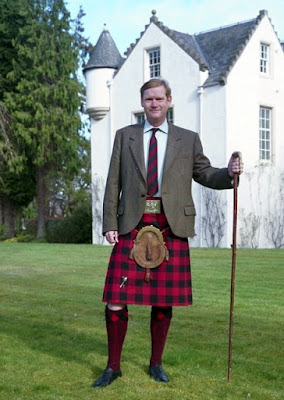Red & Black MacGregor (Rob Roy)
This tartan existed long before individual tartans became associated to particular clans Perhaps because it is one of the easiest setts to weave. There are those who question MacGregors' claim to this tartan as there are portraits of monarchs and other Highlanders wearing this sett. It is also claimed that it is not known what MacGregors would have worn during proscriptions and that they would not have worn their clan tartan so proudly. Two points here. First, I would argue strongly that due to proscription, the clan adopted it in 1603 because at that time it was not regarded as a MacGregor Tartan. It is my belief that by the end of the 18th century, nearly 200 years later, it came to be regarded as such. It is a fact that my family have worn this particular tartan since the late 18th century and regarded it as MacGregor tartan. My great. great. great, great grandfather would have worn it for good traditional reasons (see below), not on a whim. The tartan is included in the Highland Society of London's collection of 1816, which lends credence to this belief.
Secondly, if the MacGregors themselves survived the proscriptions - is it so surprising that the tartan survived? Laws passed in Edinburgh and London were difficult to enforce in the Highlands and it is quite possible that in the Highlands people would have worn the tartan of their choice. The wearing of a particular tartan demonstrates a blood connection with a particular clan. Even my kinswoman, Miss Jean Rollo, who lived in Edinburgh in 1746, made it a point to wear a tartan gown in the Canongate in defiance of the law!
This tartan has also been misappropriated as 'Rob Roy'. Kenneth MacLeay, in his book Highlanders of Scotland written in 1870, states:
"The famed Rob Roy was a cadet of the Glengyle family. The MacGregor Tartan, common like other tartans, to the whole clan has erroneously been styled 'Rob Roy' in the shops".
My belief is that thanks to Sir Walter Scott and his book, Rob Roy, the imagination of many people was gripped by the romance of it all and the tartan industry spotted a marketing opportunity and named it Rob Roy in defiance of the accepted norms of the time.
D.W. Stewart, in his Old and Rare Scottish Tartans, says:
“The pattern is accepted by solid authorities as the MacGregor pattern. There are some examples of it in the collection of tartans made by the Highland Society of London 1816/l7 labeled and sealed, “The MacGregor tartan for undress ordinary clothing. The seal and arms of 'Sir John MacGregor Murray of MacGregor, Baronet.’"
Letters dated 1792 and 1794 were sent with patterns to Wilson of Bannockburn, the great tartan outfitters of the day, for an order.
This tartan should be known as the MacGregor Red and Black.
By Sir Malcolm MacGregor of MacGregor, Chief of clan Gregor.



Comments
Post a Comment